|

by ken
January 20, 2011
from
ModernSurvivalBlog Website
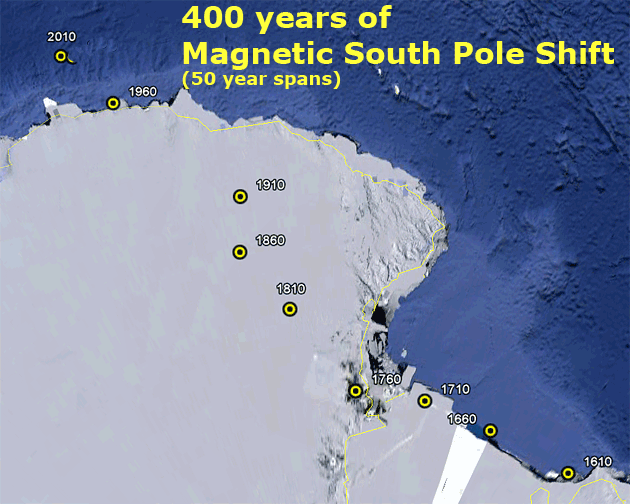
400-years-of-magnetic-south-pole-shift
While the speed of the earth’s magnetic north pole shift has
drastically sped up lately to about 34 miles per year (55 km), let’s
look at what is happening with the south magnetic pole.
Every magnetic field has two polarities, North and South for
example, and one might think that whatever is happening with one
pole would be happening (in the inverse?) to it’s opposite pole.
Well as it appears, the earth’s magnetic south pole is not behaving
similarly to it’s opposite north pole. In fact, it’s drift, or pole
shift, is actually slowing down! Presently it’s only moving 3 miles
(5 km) per year, only a tenth the speed of the north!
Pole coordinate data sourced from
NOAA’s National Geophysical Data
Center:
Not only that, but it is interesting to note that both the north and
south magnetic poles are favoring one side of the earth - the south
pole is heavily favoring one side, and continues to move further
away from true south.
The south magnetic pole is actually 1,800 miles (2,900 km) away from
the earth’s true south pole! That is a substantial offset.
The north magnetic pole is fairly near true north and is ‘only’
about 360 miles (580 km) away.
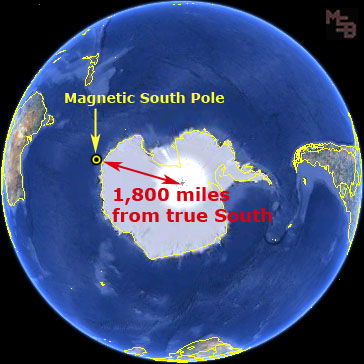
earth-magnetic-south-1,800-miles-from-true-south-pole
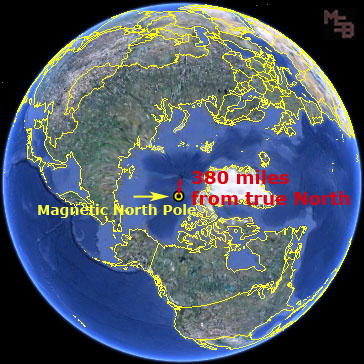
earth-magnetic-north-360-miles-from-true-north-pole
When the earth is visualized with its magnetic poles more offset and
favored towards one side of the planet than the other (which it has
been for some time - although the south magnetic pole is moving even
further to the favored side), coupled with the large variance in
shift speed between the north and south, explanations may seem
bizarre.
Since we know that the earth’s magnetic field is generated from the
spinning liquid molten iron Outer Core (encapsulating a solid iron
Inner Core), is one part of the Outer core churning differently than
the other?
Could the Outer Core, or part of it, be offset somehow, causing the
magnetic pole axis to pass through one side of the planet more than
the other? Wouldn’t that cause the planet to wobble?
Is the iron consistency changing in one part of the Outer Core more
than the other?
If the Outer Core is ‘centered’ with the rest of the earth, and the
molten iron composition is considered to be relatively consistent,
do these observations indicate that the magnetic axis is actually
bending or warping as it passes through the planet?
These are all interesting things to think about (for some of us),
and while being just a logical minded casual observer, there is no
doubt that these earth changes are powerful ones - even if only
occurring relative to the time frame of the planets life.
Take a look at the following graph and see the extreme difference in
North versus South Pole Shift speed since about 1930. As they say, a
picture’s worth a thousand words…
Something’s
happening up north…
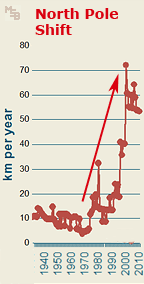
graph-comparison-north-south-pole-shift
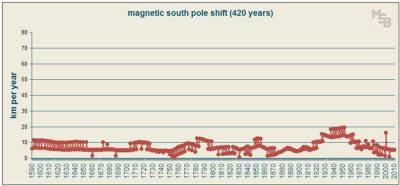
420-year-graph-of-annual-magnetic-south-pole-shift
As you can see, I spent a lot of time on
graphics today.
Observe the magnetic pole axis tilt, and the fairly precise
indication to the part of the planet that is favored more-so by
proximity to the magnetic axis.
Could crustal movements, earthquakes and volcanoes be affected
differently on this side of the planet than the other? The location
is certainly right on top of the pacific ring of fire, and very near
the general vicinity of Indonesia (most active volcanoes in the
world), and located in the part of the world that gets the majority
of earthquakes. It could purely coincidental, but who’s to say…
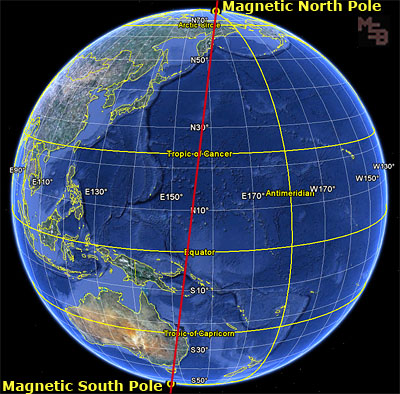
magnetic-north-south-pole-axis
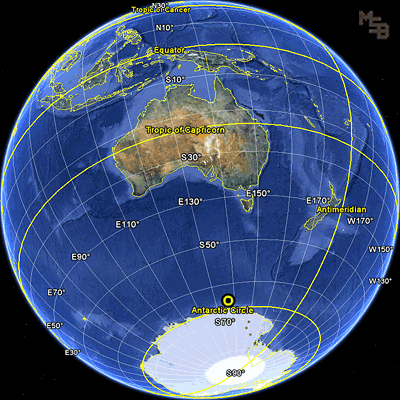
magnetic-poles-favor-pacific-ocean
Checked your compass lately??
Update
The following excerpt from a Reader E-mail, helps clarify
what is happening underneath:
The liquid part of the earth’s core is the outer core, the inner
core is believed to consist of solid iron, nickel and traces of
heavy elements. An assumption that many people make, is that the
transition between the inner and outer core is smooth like the
transition between the layers of an onion.
This is completely incorrect, the transition between these two
structures is very complex, being a mixture of solid, liquid and
in-between states which may be 10s or hundreds of miles thick. This,
and the
Coriolis effect gives rise to very complex eddy currents
within the liquid outer core which in turn create a very complex
magnetic field which is constantly changing.
Many texts approximate the earth’s magnetic field as a bar magnet
located between the two geographic poles, but this is an over
simplification with the true magnetic field being very hard to
describe.
It is true that at this time the predominant field direction in the
northern hemisphere is north, but the strength of this field varies
significantly from location to location.
If you investigate the
magnetic field you will find that there are areas of north polarity
(and always have been) in the southern hemisphere and likewise areas
of south polarity in the northern hemisphere.
|







